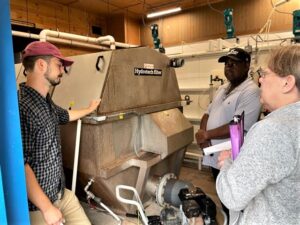
Jordan Vennes, Richfield Water Resources Engineer, explains how this machine removes phosphorus from the water in Taft Lake to Charles Rodgers and Kathryn Kelly.
BY KATHRYN KELLY
Lake Hiawatha is impaired with phosphorus. Much discussion has happened over the past few years about how to resolve this issue. What is the solution? There are several possible solutions: (1) implement natural wetlands (called constructed wetlands), (2) control the sources of excess phosphorus, and/or (3) phosphorus mitigation through chemical process.
1. Recent plans have proposed natural (constructed) wetlands to reduce phosphorus in Lake Hiawatha. The Environmental Protection Agency (EPA) site selection guidelines reveal that use of constructed wetlands at Lake Hiawatha would not meet criteria needed for a successful implementation, thus making it an inappropriate solution for Lake Hiawatha. These criteria include:
– Do not implement in a flood plain (Lake Hiawatha and Hiawatha golf course are in a flood plain).
– Do not implement near other properties (the park is surrounded by a residential area).
– Do not implement in an area with a high throughput of water (Lake Hiawatha has one of the highest throughputs of water in the state of Minnesota).
– Do not build on peat (soil surrounding Lake Hiawatha is heavy in peat).
2. Other solutions include controlling and mitigating the sources of the phosphorus. Best practices say this should be the first solution to be considered. Some measures are already in place. Minnesota state law prohibits the use of phosphorus on turf grass in the metro area, including golf courses and parks, which reduces phosphorus release into the lake over time. Also, policies are in place to encourage people to keep plant material out of the storm sewers. Future plans may include further enhancement of the natural buffers around Lake Hiawatha to mitigate phosphorus runoff. Plus, all communities in the watershed can implement Best Management Practices by mitigating phosphorus introduction at all outfalls to Minnehaha Creek. These measures would help to reduce the amount of phosphorus coming into Lake Hiawatha.
3. A third solution would treat the water in Lake Hiawatha by a chemical process called flocculation. One method introduces a chemical into the lake that binds the phosphorus to create floc, which sinks to the lake bottom. This is a one-time treatment solution. This process has been done at Bald Eagle Lake in Hugo, Minn. Another possibility is to construct a flocculation facility at Lake Hiawatha. Under the leadership of Hennepin County Commissioner Debbie Goettel, former mayor of Richfield, such a facility was built at Taft Lake in Richfield. This facility continually takes in water from Taft Lake, removes phosphorus from the water by cleaning it as it passes through the facility, and returns the cleaned water to Taft Lake. The cleaned water then travels on to Lake Nokomis and Lake Hiawatha. In 2020 the facility removed 12.87 pounds of phosphorus from Taft Lake, or 73% of the phosphorus in the processed water. Richfield staff indicates that it costs about $50,00-$60,000 in annual maintenance costs for the facility, and the floc containing the phosphorus empties into the sanitary sewer and receives treatment at the MCES wastewater treatment plant.
The Richfield flocculation facility is a great example of just one of the existing solutions that need to be considered by government leaders (city, county, regional and state) as part of a comprehensive plan to fix the phosphorus problem in Lake Hiawatha.






















